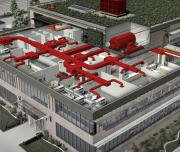An environmentally conscious HVAC upgrade can reduce energy usage bills by lowering resource consumption and improving the indoor environment for human health and productivity. These benefits are diminished if the system is not well maintained. Auditing and commissioning the HVAC system and creating an equivalent HVAC management plan are essential to achieving sustained performance over time.
The process of ensuring that your building is operating properly starts with commissioning. In general, commissioning is the process of ensuring that a building performs according to its design intent and the needs of its owners and occupants. Commissioning can seem expensive, but the resulting simple payback periods are typically less than 2 years and often less than 0.5 year. Additional benefits include extended equipment life, increased tenant satisfaction through improved space comfort, improved indoor air quality, and fewer O&M emergency calls.1 There are several types of commissioning:
| What Type of Commissioning Should I Choose? |
| My Building is... | Consider... |
| ... new or going to be undergoing major renovation. |
Commissioning – ideal for new construction or major renovation, and best implemented through all phases of the construction project. |
| ... old and expensive to operate and experiencing a lot of equipment failures. |
Retro-commissioning – ideal for older facilities that have never been through a commissioning process. |
| ... relatively new and was commissioned during construction, but energy use has been increasing. |
Re-commissioning – ideal to "tune-up" buildings that have already been commissioned, bring them back to their original design intent and operational efficiency. |
| ... large and complex, has a metering system and a preventive maintenance program, but still has high energy use and tenant complaints. |
Continuous Commissioning – ideal for facilities with building automation system (BAS), advanced metering systems, and well-run O&M organizations. |
1. DOE Federal Energy Management Program - Operations & Maintenance Best Practices
The Federal Energy Management Program’s guide Operations & Maintenance Best Practices has detailed guidance and checklists on the maintenance of boilers, steam traps, chillers, cooling towers, building automation systems, air handling units, fans, pumps, and other equipment.
The most frequently cited measures/opportunities are:
- Adjust reset and set-back temperatures and temperature settings – Settings are often adjusted over time based on personal preferences, to compensate for inadequate system operation, or to achieve energy savings. In addition, sensors require periodic recalibration.
- Staging/sequencing of boilers, chillers, and air handling units – Equipment should be operated in the most efficient combination of chillers, boilers, and fans at varying load conditions.
- Adjust and repair dampers and economizers – Malfunctioning or poorly tuned dampers (including seals, actuators, and linkages) and economizers result in (1) increased supply air fan energy in the closed position or require additional air heating and cooling when open too much, (2) undesired building operating conditions due to lack of outside air, and (3) premature equipment degradation and replacement.
- Modify control strategies for standard hours of operation – Motors, pumps, fans, and air handlers often operate on a 24/7 schedule even though not required by either the building tenants or the building operating plan.
- Eliminate simultaneous heating and cooling – Heating and cooling systems for the same space can compete against each other due to improper setpoints.
- Air and water distribution balancing and adjustments – Systems require rebalancing due to drift and changing building/workspace mission and/or tenant requirements.
- Verify controls and control sequencing including enabling and re-enabling automatic controls for setpoints, weekends, and holidays. Verify that overrides are released.
Provide an easy to follow and convenient platform for building occupants to report noticeable malfunctions or complaints about the HVAC system to maintain the desired functionality of the system and portray a sense of ownership for the occupants. Establishing a dedicated hotline will reduce maintenance turn-around times and growing HVAC energy loses and reduced occupant comfort.

